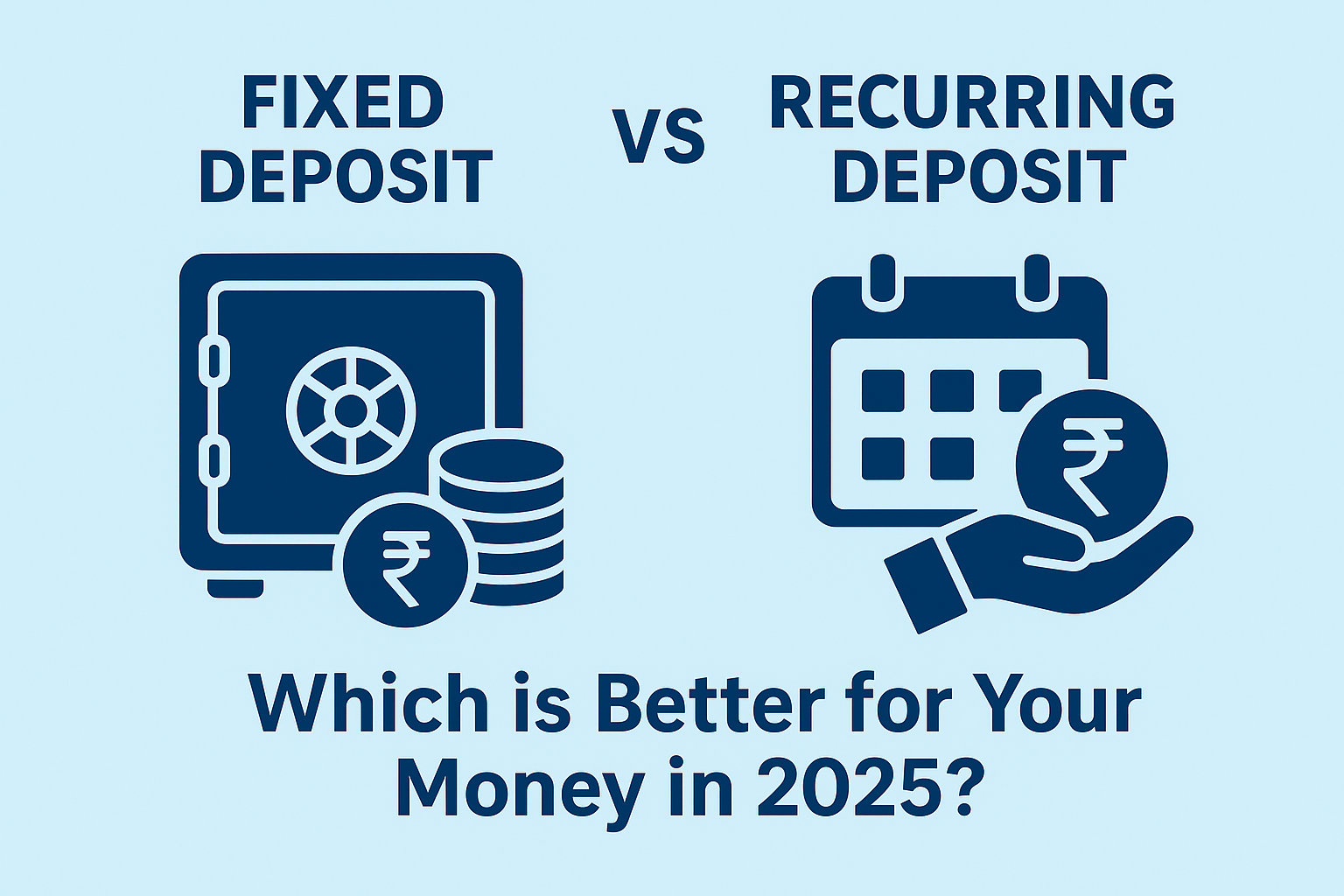In India, when it comes to safe and reliable investment options, Fixed Deposits (FDs) and Recurring Deposits (RDs) are two of the most popular choices. Both offer guaranteed returns, flexible tenures, and complete protection from market risks. But while they share similarities, they serve different types of investors.
So, if you are confused about which one to choose—FD or RD—this article will help you understand their features, benefits, and differences in detail.
What is a Fixed Deposit (FD)?
A Fixed Deposit is a one-time investment where you deposit a lump sum amount for a fixed tenure at a predetermined interest rate. The bank or post office pays interest either periodically or at the end of the maturity period.
- Tenure: 7 days to 10 years
- Interest Rate (2025): 6%–8% per annum, with an additional 0.25%–0.75% for senior citizens
- Minimum Deposit: Usually ₹1,000
- Liquidity: Premature withdrawal allowed but attracts a penalty
Example: If you invest ₹1,00,000 in an FD at 7% interest for 5 years (compounded quarterly), you will receive around ₹1.40 lakh at maturity.
What is a Recurring Deposit (RD)?
A Recurring Deposit is a savings option where you deposit a fixed amount every month for a chosen tenure. It is especially suitable for salaried individuals or those with regular income.
- Tenure: 6 months to 10 years
- Interest Rate (2025): Similar to FD, usually between 6%–8% per annum
- Minimum Deposit: As low as ₹100 per month
- Liquidity: Premature closure allowed, but with reduced interest
Example: If you deposit ₹5,000 every month for 5 years at 7% annual interest, you will invest ₹3,00,000 and receive about ₹3.60 lakh at maturity.
FD vs RD: A Detailed Comparison
Feature Fixed Deposit (FD) Recurring Deposit (RD)
Investment Type One-time lump sum Monthly installment
Best Suited For Investors with surplus funds Salaried or small savers
Returns Higher, as the amount is invested upfront Slightly lower, as funds are added monthly
Minimum Investment Around ₹1,000 As low as ₹100 per month
Liquidity Premature withdrawal allowed (penalty) Premature closure allowed (penalty)
Interest Rate (2025) 6%–8% (senior citizens up to 8.5%) 6%–8% (same as FD)
Advantages and Disadvantages of FD
Advantages
- Higher maturity amount due to upfront deposit
- Attractive interest rates, especially for senior citizens
- Safe and reliable investment option
- Flexible tenure ranging from short-term to long-term
Disadvantages
- Requires a lump sum investment
- Lock-in period reduces liquidity
- Premature withdrawal results in penalty
- Advantages and Disadvantages of RD
Advantages
- Encourages disciplined monthly savings
- Suitable for individuals with regular income
- Low entry point makes it accessible to everyone
- Safe and predictable returns
Disadvantages
- Returns are slightly lower than FD
- Missing monthly payments can attract penalties
- Not ideal for those who already have lump sum savings
Which One Should You Choose?
Your choice between FD and RD depends largely on your financial goals and current financial situation.
Choose FD if:
- You have a lump sum amount to invest.
- You are saving for long-term goals like higher education, retirement, or buying property.
- You want to maximize returns with a one-time investment.
Choose RD if:
- You have a fixed monthly income.
- You want to build a habit of disciplined savings.
- You are saving for short- to medium-term goals like vacation, gadgets, or children’s school fees.
Current FD and RD Interest Rates (2025 Snapshot)*
- SBI: 6.50% to 7.10% (senior citizens up to 7.60%)
- HDFC Bank: 6.60% to 7.25%
- ICICI Bank: 6.70% to 7.20%
- Post Office RD: 6.70% (government-backed)
- *Rates vary by bank, tenure, and amount. Always check the latest rates before investing.
Final Thoughts
Both Fixed Deposits and Recurring Deposits are excellent low-risk investment options. If you already have a large sum of money, FDs will give you higher returns and stability. But if you want to save gradually with smaller amounts, RDs are the right choice.
also read:Ration Card New Rules 2025 लागू – क्या आपको भी मिलेगा मुफ्त राशन? अभी चेक करें
In fact, many smart investors use a combination of both to balance their financial goals. FDs secure long-term wealth, while RDs help achieve short-term financial milestones with regular savings.
Whether you choose FD or RD, the key is to start early and remain consistent in your investment journey.






